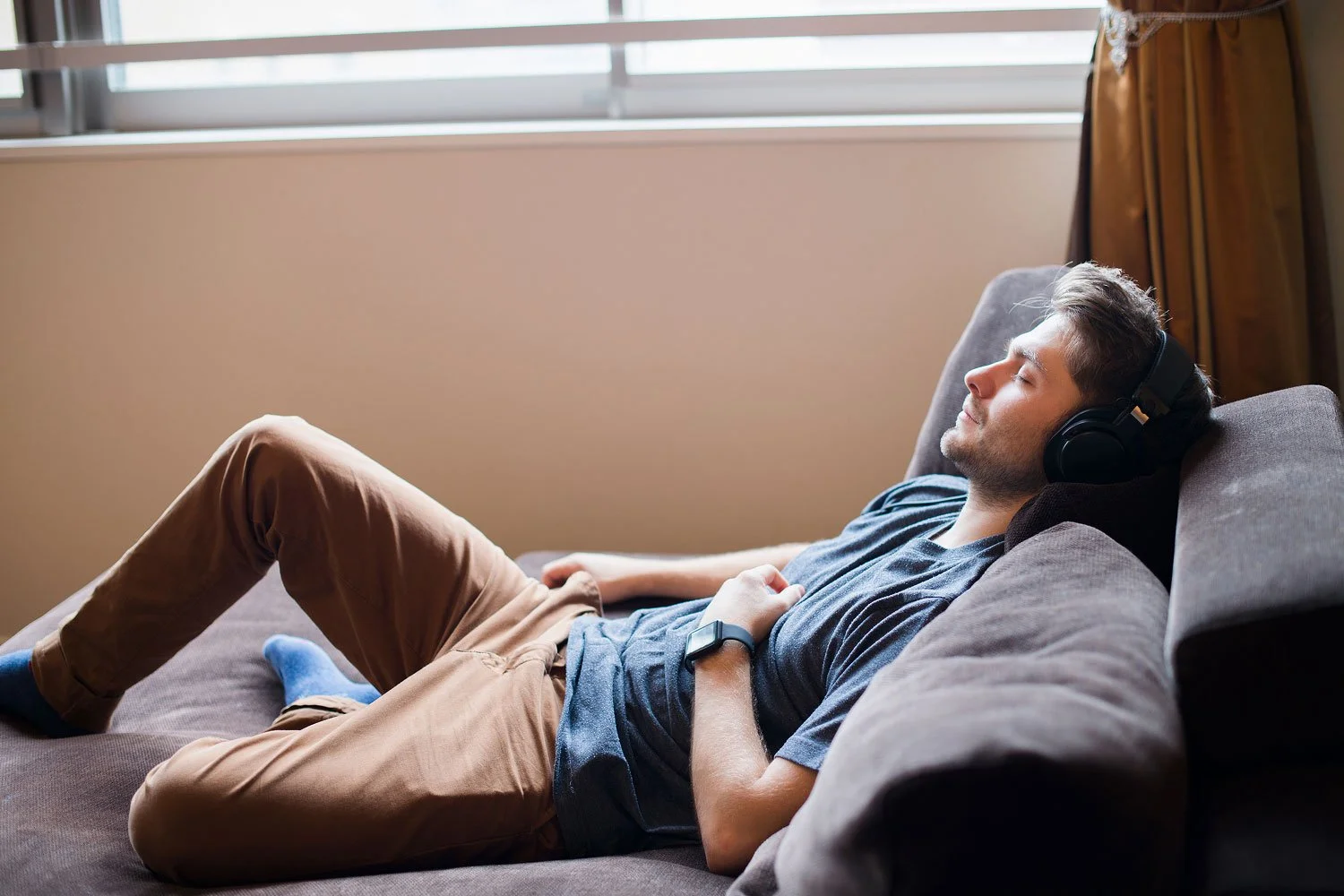Can bilateral stimulation ease your anxiety? Here's what to know

Clinically reviewed by Dr. Chris Mosunic, PhD, RD, MBA
Curious about bilateral stimulation? Explore how this calming technique works, why it can help your anxiety, and 7 tips for trying it for yourself.
Anxiety can show up at any time, and when it hits, it tends to feel like that uninvited houseguest that overstays their welcome. (You know the one.) Sometimes anxiety dominates your energy so much that you forget to respond to emails, have an afternoon snack, or even take your daily medications. Not only can this interfere with your life, but it’s also incredibly exhausting.
This is where bilateral stimulation comes into play.
Bilateral stimulation is a technique that more and more people are trying to help ease their anxiety and calm their minds. It involves alternating sensory input by stimulating different parts of your brain. But does it actually work? Let’s unpack the science behind bilateral stimulation and find new ways to bring you back into your body when anxiety feels all-consuming.
What is bilateral stimulation?
Bilateral stimulation uses rhythmic and alternating sensory input on various parts of the body. Common types of stimulation include tapping your hands or legs from left to right, listening to sounds that bounce between your ears, or slowly moving your eyes from side to side.
The idea is to stimulate both hemispheres of the brain in a coordinated pattern. It’s best known for its role in eye movement desensitization and reprocessing (EMDR), which is a trauma therapy where therapists guide clients through distressing memories while using bilateral cues to support emotional processing.
You don’t have to use bilateral stimulation solely in therapy. People use simpler versions of it on their own to manage everyday anxiety and emotional overwhelm. In general, it’s about finding a calming rhythm that helps you feel more grounded, present, and regulated in the moment.
How does bilateral stimulation work?
The exact science is still evolving, but there are a few theories about why bilateral stimulation can help ease anxiety. One theory is that it encourages communication between the left and right hemispheres of the brain. This integration may then help reduce the emotional charge of certain memories.
Another theory suggests that bilateral stimulation engages the parasympathetic nervous system, which governs rest and relaxation. The gentle and repetitive rhythm can then send signals of safety to the body, reducing the intensity of the fight-or-flight response. For some people, it can also help to give their mind a repetitive task that can then interrupt their anxious spirals without suppressing their emotions.
Some researchers even see similarities between bilateral stimulation and REM sleep, because during REM sleep, the eyes naturally move back and forth, and the brain does some of its deepest emotional processing.
Is bilateral stimulation safe?
Bilateral stimulation is generally safe for most people to try on their own, especially when using gentle methods like tapping or alternating sounds. One of the great advantages of bilateral stimulation is that it doesn’t require any special tools, training, or a controlled environment, such as a therapist’s office. You can try it right where you are.
Of course, it may not be right for everyone. If you’re navigating trauma, panic, or a mental health diagnosis, this method can sometimes bring up strong emotions. In those cases, trying it without a therapist could feel overwhelming rather than soothing.
5 potential benefits of bilateral stimulation for anxiety
This type of stimulation can offer a small, meaningful shift when things feel overwhelming. Here are five ways it can potentially help you:
It may ease anxiety in real time: Bilateral stimulation could help calm your anxious thoughts by giving your nervous system a rhythmic and grounding focus.
It may support emotional regulation: It could help balance your emotional responses by giving you space to respond rather than react.
It might help you feel more grounded: Physical methods like tapping or walking could help reconnect you with your body when anxiety starts to pull you into your head.
It’s simple and accessible: There are no apps or special gear needed. All you need are your hands, breath, or possibly a pair of headphones.
It might break anxious thought loops: Focusing on rhythm could help interrupt repetitive thinking and create space for clarity.
How to try bilateral stimulation: 7 tips for relief
If you’re anxious, bilateral stimulation can be a great tool to help bring you back into balance. Here are seven tips to help you find some relief using this technique.
1. Start with simple, self-directed tapping
Sit comfortably, and begin gently tapping your hands on your thighs in an alternating left-to-right pattern. Think to yourself: tap left, tap right, tap left, tap right. Try this for 30 seconds while breathing naturally.
This can help calm your racing thoughts, ground you in the present, and ease physical tension. You could also use your fingertips to tap your collarbones or shoulders if tapping your legs isn’t possible or feels strange.
2. Use bilateral audio to get in the zone
Many free YouTube videos offer bilateral or binaural audio tracks that alternate sounds between the left and the right ear. So, pop in your headphones and listen to a calming sound, like ocean waves or ambient music, that pans back and forth across your headphones.
Listening to this can help you wind down and also help improve your focus.
💙 Reset your nervous system by listening to the Bilateral Stimulation (EMDR) for Burnout Recovery playlist.
3. Practice mindful walking (and notice your steps)
Walking is a built-in form of bilateral stimulation because of the natural left-right motion of your legs. To amplify this effect, bring mindful attention to your steps. As your left foot hits the ground, say “left” in your mind, then “right,” and just notice the rhythm.
Becoming aware of your steps can help ground you and also soften your spiraling thoughts (here are 10 more tips to help you stop the spiral).
4. Use objects to practice visual bilateral stimulation
Take a small object, like a pen or your finger, and slowly move it left to right in front of your eyes. Follow it with your gaze, but keep your head still. Do this for about 20–60 seconds.
Moving an object like this can help with emotional processing and re-centering after being overwhelmed. The motion should be gentle and not too fast.
Read more: Feeling overwhelmed? Try these 6 emotional resilience tips
5. Sync with your breath
Combine gentle bilateral stimulation with breathwork for extra grounding. To do this, tap your left thigh as you inhale and your right thigh as you exhale. You could also alternate steps as you breathe in and out while walking.
The goal is to create a rhythmic pattern that links your breath with bilateral motion, which can deepen your relaxation and sync your body and mind.
6. Create a consistent practice
Bilateral stimulation tends to work better when you’ve built familiarity with it before you really need it. So, try weaving it into your routine in small, low-pressure ways.
Consider two minutes of thigh tapping before bed, listening to a bilateral audio track during your lunch break, or going on a mindful walk after your morning coffee. This can help build resilience and create predictability for your nervous system.
Read more: How to create the best daily routine: 10 simple habits for success
7. Pay attention to what doesn’t feel good
If any technique feels overstimulating or emotionally intense, take a pause. If you start to feel lightheaded, overwhelmed, or your thoughts speed up instead of slowing down, take a breather.
This is your body’s way of telling you the timing isn’t right, and that’s okay. You can always return to it when you’re in a different headspace.
💙 If you’re feeling overwhelmed, take one minute to Pause to Breathe in this meditation with Professor Megan Reitz.
Bilateral stimulation FAQs
Is bilateral stimulation safe to try at home?
Bilateral stimulation is safe for most people. In general, trying bilateral stimulation at home using gentle techniques like tapping, listening to audio, or walking is considered low-risk. That said, if you’ve experienced trauma or complex post-traumatic stress disorder (PTSD), you might want to approach it with caution.
While some find it soothing, others may feel overwhelmed, especially if strong emotions surface unexpectedly. In those cases, it’s a good idea to check in with a therapist before continuing on your own.
What does bilateral stimulation feel like?
Many people describe it as a gentle, calming effect or a sense of becoming more present in their bodies. Others say it feels like their thoughts slow down, they feel soothed, or they just feel a little sleepy.
That said, not everyone feels an immediate change. It may take a few tries to recognize what it’s doing for you, or it might not feel like much at all, and that’s valid too.
Can I use bilateral stimulation without a therapist?
You can use this method without a therapist, especially for light-touch use cases like general stress and everyday anxiety. Many people use bilateral stimulation informally as a self-regulation tool, tapping during a tough phone call or listening to alternating tones to wind down.
But if you’re using this method to work through intense emotional memories or trauma, having professional support can make a big difference. Therapists trained in EMDR or somatic practices can help guide the process so it’s supportive and not destabilizing. Here are six things to consider before doing EMDR.
Does bilateral stimulation actually help anxiety?
There’s a growing body of research that suggests that bilateral stimulation can help reduce anxiety, emotional distress, and symptoms related to trauma.
Additionally, anecdotal reports suggest it could help people calm their nervous system and shift out of negative thought loops. It’s not a cure, but it can be a helpful part of an anxiety management toolkit.
How often should I use bilateral stimulation?
There’s no strict schedule or dosage. Some people use it daily, like a morning grounding practice. Others reach for it in the moment during things like panic attacks or transitions that feel hard to manage.
You could start with just two minutes a day and adjust based on how your body responds. The important thing is to use it intentionally as a way to stay connected and calm while you move through your feelings.
Calm your mind. Change your life.
Mental health is hard. Getting support doesn't have to be. The Calm app puts the tools to feel better in your back pocket, with personalized content to manage stress and anxiety, get better sleep, and feel more present in your life.







